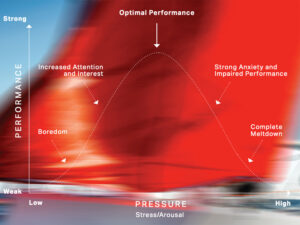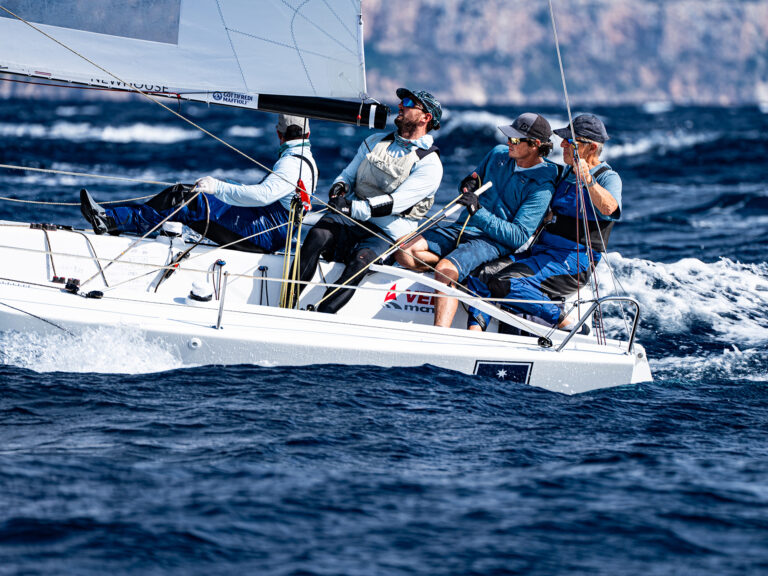
2009 Sperry Top-Sider St. Petersburg NOOD
In one race of the Spring Soling Bowl off Annapolis in a dying northwesterly, we led up the second beat until nipped at the mark by Manfred Kantor, of Canada, who had come in from the right corner. After rounding, instead of recognizing that Kantor’s success might have indicated something good off to the east, we both headed west, in very light air, high on starboard jibe, toward the dark line of the sea breeze advancing up the Severn River about 30 feet to the right of our rhumbline. We were both convinced that getting away from the dying northwesterly and into the approaching sea breeze was essential to winning the race.
Although our spinnakers were barely lifting, the fleet astern, some of whom had jibed to port a quarter-mile back, looked to be in even less wind and, at first, the gap between us widened. But then we noticed the sea breeze line was not advancing. It was no longer as dark as it had been. When we were about halfway down the run, the last boats, on port jibe, a half mile astern and to our left, started to move. The fleet rapidly turned inside out.
We jibed to try to reach their wind before it was too late, but it was already too late. Four boats carried the northwesterly across in front of us and almost all the way to the finish. The sea breeze finally filled, first on our side of the line as Kantor crossed in fourth, and then, as we salvaged sixth, spread across the entire course. All of the boats that had jibed left at the mark into the last vestiges of the offshore gradient wind (brought to the surface by thermal turbulence over the nearby peninsula had beaten all of those who had opted for a direct shot at the sea breeze.
The dying of an existing wind and the development of a new one at midday almost always means that a thermal wind is undermining and replacing a gradient wind, thereby creating “two winds simultaneously.” The presence of two winds makes one side of the course obviously advantaged, may justify heading immediately from the start toward the advantaged side and continuing until the advantage or the layline is reached, but the advantage, notwithstanding the common belief, is not necessarily on the side from which the new wind is developing. Some sailors (John Sherwood, for example) don’t head for anything invisible on the water. They wait until the new wind has appeared before heading for it, and that’s good advice.
Read more Stuart Walker stories from the Sailing World archive.
But we had waited; the new wind had appeared; it was obvious, a strong dark line only a mile ahead. And we were still wrong; the advantaged side had been to the left, away from the new wind.
Conditions in which one side is obviously advantaged are the least common of the three typical wind scenarios in a race, but it seems to be the one most used. In professional match racing (with the aid of a team meteorologist, a tactician, and a strategist) a deliberate choice is typical: “They seem to want the right.” The implication is that there is something on the right that is better than on the left, and that they know about it. The average sailor mimics this behavior, presumes that an advantage exists, and acts as if he knows what it is. Although one side often turns out to have been advantaged, predicting during the next 25 to 30 minutes which side that will be is actually quite difficult.
The development of a new wind is a particularly unreliable reason for an immediate move to one or the other side of a beat. The most reliable reasons, in order of certainty (and none are certain), are as follows:
➤ A persistent shift or an alteration in velocity due to channeling
If local knowledge includes the presumption that the existing wind will shift or alter in velocity as it bends around or passes near a shoreline feature (particularly if the airflow is cold and the feature prominent), presume that it will create an advantage on one side of the course and head for it.
➤ Divergence and veering in a parallel-to-shore wind
In a parallel-to-shore flow with water on the wind’s right, acceleration and veering of the overwater segment takes place in a near shore band as it diverges from the slowed overland segment. This results in a near certain advantage on the right side of the beat, is only slightly less common than reason No. 1. Whenever a racecourse is set so that a significant portion of the starboard layline lies within one-quarter mile of a shore to the right, head for that shore.
➤ A major difference in the current velocity between the two sides of the course
Management of this condition (tacking immediately to the advantaged side) should be limited to circumstances in which you have measured the difference in velocity with a current stick and in which, short of the laylines, the difference is significant.
➤ A persistent shift due to a velocity veer (or in the Southern Hemisphere, a velocity back)
If, in the early part of the afternoon, the local sea or lake breeze usually increases in velocity, it will veer as it does so. Restrict the presumption that a velocity veer will advantage the right side of the course to sea/lake breezes in early afternoon.
➤ A near-shore veer in an insolating, offshore wind (particularly a sea/lake breeze blowing over and off land)
Thermal turbulence above a sun-warmed surface regularly induces downdrafts of higher velocity, upper-air flow so that overland and near-shore the mixed wind is veered to that farther offshore.
➤ A dying wind replaced by a new wind (and/or two winds simultaneously)
If the wind dies during an around-the-buoys race, one can presume it is about to be replaced by a new wind, usually by a thermal wind, which results, for at least a brief period of time, in two winds simultaneously (see below).
➤ A difference in wind velocity or wave size
Differences in wind velocity (or wave size) are significant in light to moderate winds when boats are sailing at less than their hull speeds (and particularly in very fast boats whose speed continues to increase at boat speeds above their hull/length limits). However, even though such differences often cause one side of the course to be advantaged, in the places that race committees usually select (far from blanketing shores and leeward barriers), that side is rarely predictable. Even the side that in a pre-race inspection appears to have the greater velocity is unlikely to continue to do so during the 20- to 30-minute beat to come.
Read more Stuart Walker stories from the Sailing World archive.
There is little justification for strongly favoring one side in conditions other than those listed above. However, in light air one must have the courage to continue in one direction until an advantage is reached; even the wrong side is usually better than the middle. And in big fleets (except in oscillating winds) it rarely pays to tack up the middle; one should usually keep going in one direction until the wind shifts (a little, at least) your way (or two-thirds the way to the layline, if it doesn’t).
In ranking these scenarios by certainty, I place the development of a new wind in sixth place, well astern of geographic-determined persistent shifts, marked variations in current velocity, and velocity veers. The former are made near certain by their existence before the race begins and can be relied upon to continue, and a velocity veer has both an associated increase in velocity and a specific time of day to facilitate its recognition. The timing and extent of an invading new wind and the ability of a pre-existing wind to persist near shore are far less exact.
Particularly inexact is the rate of progression of a new wind. Evidence of its imminence may be limited to the diminution-less near the windward shore, farther offshore-of the initial gradient wind. Or the new wind may appear but never invade the course or never reach the mark ahead. Or it may appear, invade the course (two winds simultaneously), and be present at the mark ahead, but not reach your position. Or it may appear, spread rapidly, and sweep the old wind completely away. It is very difficult to determine which scenario will actually transpire; even extensive local knowledge may be insufficient.
Thus, the best recommendation for management is as follows: When at around midday the gradient wind begins to die, sail so as to best utilize its last vestiges. Head for the side of the course that is nearer the shore and keep directly downwind of that shore-in the zone of thermal turbulence-until the new wind actually appears at the surface. When the new wind does appear, try to determine which of the two winds is present (or will be present when you arrive) at the next mark and then head so as to reach that wind as soon as possible.
My error in the management of the first race of the Spring Bowl was failing to stay in the vestiges of the old wind until the new wind had reached the next mark. Had I jibed to port as I began the run and headed left, I would not only have covered the boats astern, but, when the new wind reached the next mark and I was halfway down the leg, I would have been ideally positioned to jibe to starboard and head for it.
In sum, the appearance of a new wind may be a one-side-advantaged condition, but the side on which it appears may not be the advantaged one!
Read more Stuart Walker stories from the Sailing World archive.









